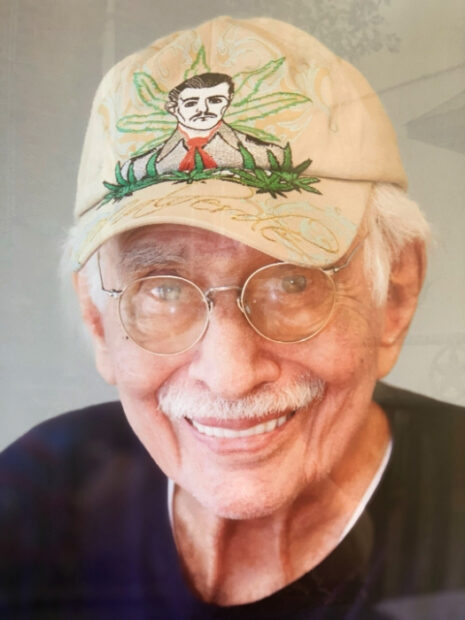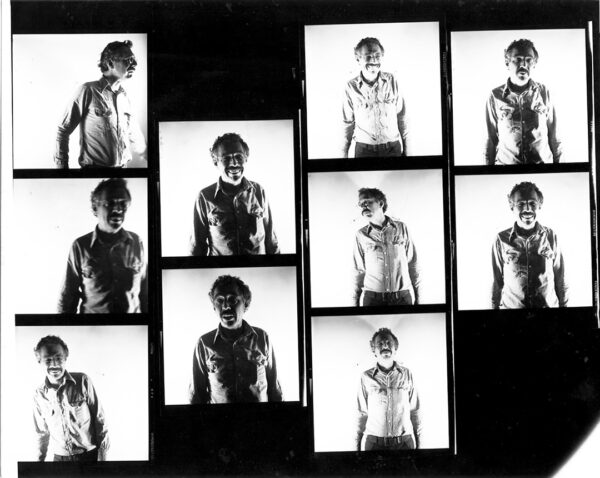James “Jim” Harithas, the Houston-based artist, curator, patron, and museum director, died on Thursday, March 23, 2023 at the age of 90. Though he may be best known as the director of the Station Museum of Contemporary Art, which he founded with his wife Ann, Mr. Harithas held several curatorial and director positions throughout his lifetime.
Born on December 1, 1932 in Lewiston, Maine, Mr. Harithas spent much of his childhood between Maine and Oklahoma before his family settled in Germany, where his father was stationed after World War II. With a mother who was a painter, Mr. Harithas’ interest in art began at a young age.
In 1952, Mr. Harithas left Germany to attend the University of Maine, where he initially studied political science. In a 2008 interview by Raphael Rubinstein for The Brooklyn Rail, Mr. Harithas explained that he dropped out of the program after seeing his first Abstract Expressionist show in Frankfurt, Germany in 1953 while visiting his parents.
He said, “It sent major tremors up my spine. Oh my God, here was pure spirit — so tangible and yet so mysterious. Within a month, I quit school and hitchhiked to New York.”
While in New York, Mr. Harithas worked in the service industry as a dishwasher and at the Hotel New Yorker as he pursued his art. However, in 1954 he was drafted into the U.S. Army. During the Algerian War, he was stationed in France, and after being discharged in 1956, he decided to stay. In 1957 Mr. Harithas was admitted into the École National des Beaux-Arts in Nancy, one of the country’s top art schools.
Mr. Harithas soon came back to the United States and finished his undergraduate degree at the University of Maine. In 1958 he married his first wife, Christina Keller, with whom he had three children. He obtained his MFA from the University of Pennsylvania, and after graduating he held a job cleaning sugar machines at the Quaker Sugar Refinery; simultaneously, he pursued his own art.
In 1962, Mr. Harithas held a curatorial position at the DeCordova Museum, Boston, and then took on a position at the Phoenix Art Museum. There he organized an exhibition featuring contemporary artists from Mexico, which received national recognition. While planning the show, he traveled across Mexico by car meeting with myriad artists, including David Alfaro Siquieros. After just a few years in Phoenix, Mr. Harithas accepted the position of chief curator at the Corcoran Gallery of Art in Washington, D.C. Then, in 1968, he became director of the museum. During his time at the Corcoran, Mr. Harithas began to work with pioneering video artists Nam June Paik and Juan Downey.
In 1970, Mr. Harithas returned to New York to teach at Hunter College and the School of Visual Arts. From 1971 until 1974, he served as the director of the Everson Museum of Art in Syracuse. In his role at the Everson, he hired David Ross (at the time a new graduate from Syracuse University, who later went on to serve as director of the Whitney Museum of American Art and the San Francisco Museum of Modern Art), as the museum’s first curator of video art. This, according to the museum’s website, was the first video-focused position anywhere in the country. At the Everson, Mr. Harithas also worked with Central New York’s incarcerated population. One day a week, for two years, he taught classes at Auburn Correctional Facility. Ultimately this work resulted in the 1973 exhibition From Within, featuring pieces by artists from Auburn, and organized in partnership with the National Collection of Fine Arts at the Smithsonian Institution.
Upon Mr. Harithas death, on the Everson Museum’s website, director Elizabeth Dunbar (herself a former director of the Houston art space DiverseWorks) remarked, “Jim transformed the E — and Syracuse — into a destination for cutting-edge, risk/taking art — he put us on the map. Jim welcomed innovation, experimentation, and a broad definition of creativity and artistic expression. Never afraid to push the envelope or break the rules, Jim was a legendary figure whose belief in trusting artists to express themselves was unparalleled and his impact can be felt to this day. He set the bar high for the Everson directors who followed, and I’m glad that he was proud of the work we are doing today. He left big footsteps behind.”
Following his time at the Everson, Mr. Harithas accepted the position of director of the Contemporary Arts Museum Houston (CAMH) and moved to the city in 1974. In the four years he worked at CAMH, Mr. Harithas presented provocative exhibitions featuring artists such as Forrest Prince, Lynn Randolph, and Terry Allen.
A recent social media post from CAMH stated, “Harithas felt that art being made in Texas was overlooked and underappreciated. He used his position to prioritize and champion local and regional artists as seen in exhibitions such as 12/Texas (1974) and Dále Gas (1977), the first institutional exhibition of Chicano art. He provided some of the first exhibition opportunities for artists including James Surls, Mel Chin, Luis Jiménez, Julian Schnabel, and Bert Long. Harithas is often described as larger than life, and his tenure at CAMH was marked by inclusiveness, innovation, and some controversy, including a several hundred person food fight during the opening of Antoni Miralda’s 1977 exhibition. His decisions were bold and often groundbreaking, including the creation of the Museum’s video art curator role.”
In 1978, Mr. Harithas married artist and curator Ann O’Connor William. The pair did much to support the Houston arts community — together they co-founded both the Art Car Museum and the Station Museum of Contemporary Art, where Mr. Harithas would serve as director.
In the 2008 interview by Raphael Rubinstein, Mr. Harithas spoke about some of the issues within museums and his political exhibitions. He remarked: “…I must say I’m interested in artists not museums. I think museums have failed to reach most of the people. We need new kinds of museums. With my wife, Ann, I also founded and initially organized the Art Car Museum. It has a huge working class audience. It not only exhibits radically altered cars but it also mounts political shows… For example, the week after 9/11, we opened an exhibition in the Art Car Museum against Washington’s and the Bush administration’s international policies with statements on the walls by Noam Chomsky, Robert Fisk, and Edward Said. The FBI and Secret Service tried to interfere or even close the show but Houston would have none of it. The Houston Chronicle in the lead editorial told the FBI to stay out of the art world and look for terrorists elsewhere. Much of the public was outraged and we received many letters in solidarity.”
Throughout their lives, Mr. and Mrs. Harithas had a major impact on the arts in Houston and beyond, through both the thoughtful and bold exhibitions they presented at the organizations they founded, and their support of emerging arts organizations and artists. Pete Gershon, who has written books on Houston’s art history, told Glasstire that many artists Mr. Harithas exhibited had not previously had opportunities in Houston.
Mr. Gershon said, “Jim and Ann had a radical artistic vision and the financial means to implement it. With no boards or granting organizations to please, the Station Museum and the Art Car Museum could program as they wished, resulting in an incredibly pure approach to art presentation. Jim seemed to always be rooting for the underdog and trying to listen to voices other people were ignoring or actively trying to silence. He brought great, tough exhibitions to the city and he elevated Houston artists in a way that nobody else did. Throughout his career he also took chances on young curators, who in many cases rose to the top of their fields. He’d meet a guy in a parking lot, have an interesting conversation, then offer him a job as a curator. Brave and bold and generous.”
Mrs. Harithas died in December 2021 at the age of 80. Last year, in November 2022, the Station Museum announced its closing. Glasstire reached out to the organization for an update, but has not received any additional information since the public statement made five months ago.
James Harithas’ family and friends are invited to attend a celebration of life, which will be held on Sunday, April 2, 2023 at the Bradshaw-Carter Home (1734 W. Alabama St., Houston, TX 77098). Visitation hours are scheduled from 3 pm to 6 pm, with a service taking place at 4 pm. Guests are encouraged to honor Mr. Harithas’ memory by wearing white.
Update: April 1, 2023: A previous version of this article stated that Mr. and Ms. Harithas founded both the Art Car Museum and the Art Car Parade. While they did found the museum, they were not the founders of the parade, although Ms. Harithas did organize a 1984 exhibition featuring two art cars. An early version of what would become the parade was organized in 1986 by Rachel Hecker and Trish Herrera in conjunction with the New Music America Festival.






4 comments
He and Ann would drive all the way from Houston to San Antonio just to hear the legendary STEVE JORDAN play his accordion like no other. They would show up often, dance the night away and marvel along with the rest of us at the greatest jazz genius that lived inside Steve Jordan. We just thought they were tourists…. RIP, Mr. Harithas and Ann. And thank you for all you did for so many.
Jim was probably the last of the great American Curators.
His belief in artists, his wild mind and personal courage were a rare beautiful thing we probably won’t see the likes of again.
I am honored to have known him and hate to think of this planet without him.
Terry Allen
I met Edd in Dallas at Raffle Martini studio in Fair Park in the 70s a fun event and so he invited myself and David McCullough to Houston and we saw what shape he was invision with the Museum and quite a character but dynamic and expansive on what is that decade in direction since it was a New decade of Modern but no real value in direction until the 1980s he will be missed like so many recently in passing have been as we enter The 21st Century.
I didn’t know Jim well, but his course on contemporary art at the University of Houston in the mid-70s was my introduction to what I considered at the time “difficult” art. I told him decades later that I was in that course, and he said, “You poor thing.” But that course enriched me greatly. In 2010, at my request, he toured my group through James Drakes’ “A Thousand Tongues Burn and Sing” at the Station Museum and to Barnett Newman’s “Broken Obelisk” at the Rothko Chapel. I always enjoyed the quirky exhibitions at the Art Car Museum and the powerful exhibitions at the Station Museum. I will miss Jim.